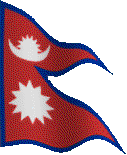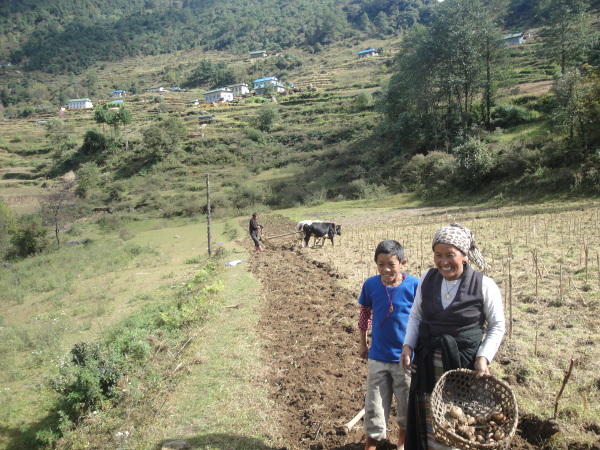
formerly Taksindu VDC 6, Solukhumbu, Nepal
now part of Solududhkunda Municipality 1
 |
The
Sherpas
of Hewa (Yawa) formerly Taksindu VDC 6, Solukhumbu, Nepal now part of Solududhkunda Municipality 1 |
|
The Sherwa are
one of the numerous ethnic groups of Nepal. Probably they are better
known under the name Sherpa. Sherwa is only the pronunciation that
has been originally used in the Sherpa mainland. In Western
countries the word is often used for persons who accompany
Europeans, Americans, Australians, Japanese, etc. on their lunatic
alpine expeditions in the Himalayas as guides or porters. But not
all who are called in this way are ethnically really Sherpas. [See
also special website on the Sherpas]
As all ethnic cultures of Nepal, that of the Sherpas is considerably endangered. The reasons have not only to do with their confrontation with Western values and lifestyle that have come to Nepal and the Sherpas since the 1950s by way of so-called development aid, scientific research, tourism and media contents. They also have to with the way they have been treated and socially classified by the ruling male elite of the country that belongs to the so-called upper Hindu castes.
Since the military unification of Nepal by the Shah rulers of the small kingdom of Gorkha in central Nepal about 250 years ago, the Nepali rulers have tried to enforce their own culture and language at the expense of the cultures and languages of the numerous other ethnic groups of the country. This state policy has never been pushed through more vehemently and ruthlessly than during the non-party Panchayat system of King Mahendra (1961-1990). Hindu values and conceptions of Nepali as the mother tongue of the ruling elite were made keystones of Nepal’s national identity. Being free from party political quarrels, the system concentrated on the implementation of these nationalist ideals.
But this phase of modern Nepali history looks completely different if it is viewed from members of the disadvantaged sections of society. If they wanted to participate in the modern Nepali state, they had no other chance than to accept this kind of nationalism, disregard their own cultures and languages and assimilate the culture and language of the ruling elite. This had devastating consequences for Nepal’s ethnic cultures. Deliberate subversion of ethnic cultures already started at school. Excellent schools like those initiated by Edmund Hillary in the Sherpa area became nationalised during Panchayat times and lost in value. If you look at the national school books of this time, you will see that they only include topics from Hindu culture and society, ethnic cultures are hardly mentioned.
Despite all these grievances, the Sherpas have been able
to preserve their ethnic language, not only in their traditional
area of settlement but also in the Kathmandu valley where the number
of Sherpas is steadily growing. This positive development has to do
with the increasing reversion to their own values that started after
1990. [Links to several dictionaries
of the Sherpa language (as well as of Nepali) are linked on
the language subdomain of Nepal Research]
The Sherpas are a relatively young group within the multi-ethnic state of Nepal. German anthropological research in the mid 1960s proved that their ancestors have immigrated across the Nangpa La mountain pass to the area Southwest of Mount Everest from the Eastern Tibetan province Kham and adjoining areas of Chinese Sichuan between 1530 and 1600 [see map provided by Michael Oppitz, Geschichte und Sozialordnung der Sherpa, Innsbruck 1968]. This also explains the name of this people. Sherpa means “people from the East (sher)”. Their original settlement area of Solukhumbu must not be mistaken with the modern district Solukhumbu. The current district is the result of several deliberate partitions of the original settlement area of the Sherpas by the rulers in Kathmandu [see maps of these prations as prpvided by Walter Limberg, Untersuchungen über Besiedlung, Landbesitz und Feldbau in Solu-Khumbu, Innsbruck 1982: traditional Solukhumbu area, partition of 1886, partition of 1961]. In the West, original Solukhumbu extended almost up to Jiri while the southeastern part of the modern district is not populated by Sherpas. Original Solukhumbu comprised three regions: Khumbu, Pharak and Shorong (Nepali: Solu). Shorong, to which the village of Hewa belongs, is the area where most of the Sherpas live at altitudes between 2.300 and 4.000 metres. The lower mountain slopes are home of other ethnic groups like Tamang, Rai, Sunuwar, Newar, Gurung, Magar, Jirel and Tibetans, but also Hindu castes like Chhetri, Brahmans (Nepali: Bahun), Kami, Damai, Sarki, Gharti and Bhujel have immigrated there over the centuries.
The climate of Shorong is moderate compared to Khumbu. There is hardly any snowfall in the main Sherpa settlement area between 2.300 and 3.000 metres, at least it does not remain lying for long. But at higher altitudes, the ground is often frozen for weeks. As everywhere in Nepal, life depends very much on the summer monsoon that brings a lot of rain between mid June and mid September.
While Khumbu Sherpas traditionally live on livestock breeding and trade with mountaineering and tourism causing greater changes, the economy of Shorong is a mixture of field cultivation, animal husbandry and trade with agriculture being dominating. The main products are potatoes, wheat, barley, maize, buckwheat and yams. Besides, the Sherpas grow beans, peas, radish, pumpkins, cucumbers, chilli and garlic on vegetable patches. Obviously, the Sherpas knew the cultivation of wheat and barley already in their original homeland in East Tibet, while potatoes have been introduced about 100 years ago, maize even 40 years ago only. Fruit trees have become more and more popular in recent decades, especially apples, peaches and apricots.
Spring and summer are very intensive times for agriculture. Between May and July, barley and wheat are harvested and sheaved before vegetables are planted. During monsoon, each potato plant is continuously cultured. They are harvested separately at the end of summer as soon as they get ripe. The cereals that have been sheaved and then stored dry in summer are threshed. The straw is stored for the animals until winter. The time between August and September is used for ploughing, fertilising and ploughing again. After this, barley and wheat have to be sown. At the same time, maize and vegetables have to be harvested. Then the fields have to be prepared for the planting of potatoes. All this work has to be completed until mid January. There are only two periods of rest: between January and March as well as one month in summer, between the harvest of cereals and that one of potatoes.
In recent years, this for Solu typical economic system has changed rapidly. If one walks through the villages, one sees year after year ever larger fallow areas. They are an unmistakable sign that agriculture is losing importance. Parts of the former farmland have been converted into pastures. At the same time, the number of cattle in the villages has increased enormously. 40 years ago, only a few animals were found in the villages, at best in the adjoining forest areas, where they were looked after by children. On the high pastures, one still finds shepherds with yak herds or related crossbreeds, but their number is likely to decrease. After all, this type of livestock farming requires the shepherds to spend six months or more on the high pastures.
 |
 |
| Two sisters cutting the grass with hand sickles
(November 2017) |
Nyima Sange ploughing the field with an ox
plough (November 2017) |
Many factors may be responsible for this change. There
are demographic changes, for example. Labour migration to the
Kathmandu valley or even abroad has an impact on economic life. But
families are also becoming increasingly smaller thanks to the
declining birth rate, i.e. there are fewer and fewer workers. The
intensive farming of earlier years is therefore no longer possible.
In addition, today all children go to school and their employment as
labour force is therefore no longer feasible. Since technical
equipment is still hardly used on the terrace fields, agriculture is
an incredibly arduous business that rests on fewer and fewer
shoulders. Livestock farming is much less labour-intensive and can
be managed by a much smaller number of workers.
The rapid expansion of the road network in Solu has also helped to
make it easier and quicker to transport goods. However, the roads
could also be used to market the farmers' own agricultural
production goods. It is therefore possible that the use of
labour-saving technical equipment could make arable farming more
lucrative again.
The Sherpa villages lie on less steep parts of the mountain slopes. Usually, they are scattered settlements; 15 to 25 houses, today often more than 30 houses, are placed in the middle of the associated fields. But sometimes you also find estates of terraced houses along the roads or paths. High above the villages and beyond the treeline are the high altitude pastures of the Sherpas where they grow their Yak herds in summer. Different from the fields in the village, these pastures do not belong to individuals but to the whole clan. Until the nationalisation of such clan lands (Nepali: kipat), this had also been true for the forest areas and was used to protect them.
The Sherpas are a Tibeto-Mongolian ethnic groups according to their immigration from East Tibet and West Sichuan. Their mother tongue belongs to the Tibeto-Burman linguistic family. It is related to modern Tibetan but it has developed independently over the past centuries. The Sherpa language has originally not been a written language but in recent years there have been efforts to introduce a written form. Some advocate to do this on the basis of the Tibetan script while others favour the use of Devanagari, the script that is used for writing Nepali. The latter has the advantage that the children do not have to learn another script since they learn to write Devanagari at the village schools.
The Sherpas are Buddhists. They belong to the oldest
school of Tibetan Buddhism, the Nyingmapa. Nyingmapa Buddhism is the
foundation of Sherpas culture. Originally, the Sherpas only had lay
Lamas as priests. First monasteries have only been introduced in the
1920s. Today, there is a steadily growing number of monasteries and,
in a far lesser number, nunneries. Besides, you find numerous
religious buildings in the settlements like village temples, Stupas,
Mani walls with inscribed religious texts (mantra) that are
circumambulated in clockwise direction.